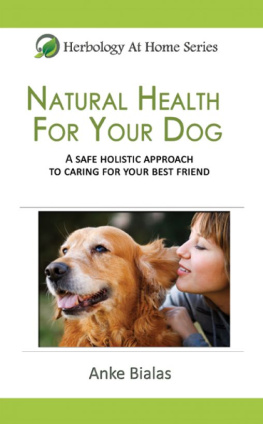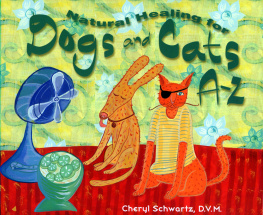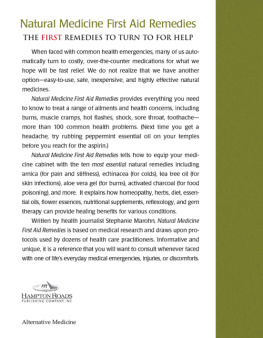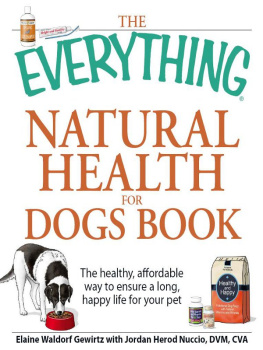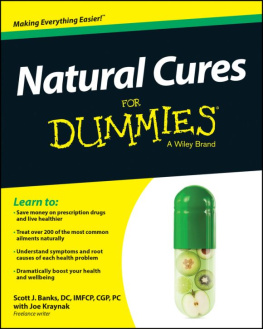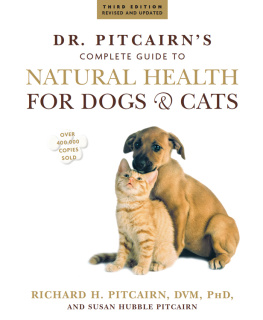Natural Health for YourDog:
Herbal Treatments for the Top 5 Health Issues
Published byNatator Publishing
Copyright 2008 Anke Bialas
SmashwordsEdition
All rights reserved. Without limiting the rights undercopyright reserved above, no part of this publication may bereproduced, stored in or introduced into a retrieval system, ortransmitted, in any form, or by any means (electronic, mechanical,photocopying, recording, or otherwise) without the prior writtenpermission of both the copyright owner and the above publisher ofthis book.
~~***~~
This book is intended as an educational reference guide only,not a medical manual. The information given here is designed tohelp make informed decisions about your health. It is not intendedas a substitute for any treatment that may have been prescribed byyour medical professional. The author takes no responsibility forthe misinterpretation and deliberate or accidental misuse of theinformation presented in this book, on the website and on anypublished Herbology material.
~~***~~
Smashwords Edition License Notes
This e-book is licensed for your personal enjoyment only. Thise-book may not be re-sold or given away to other people. If youwould like to share this book with another person, please purchasean additional copy for each person you share it with. If you'rereading this book and did not purchase it, or it was not purchasedfor your use only, then you should return to Smashwords.com andpurchase your own copy. Thank you for respecting the author'swork.
Contents
Introduction
Fleas &Ticks
IntestinalParasites (Worms)
Arthritis
PeriodontalDisease
Allergic SkinConditions
Bibliography
Introduction
~~***~~
I wrote thisbook to let pet owners know that there are natural alternatives toa lot of the synthetic (and often harmful) products on the markettoday. There is much you can do for your dogs which will not costthe earth, take much time and may be good for the environment inthe process. This book covers some of the top health problemspresented in veterinary clinics today and is designed to get youinterested in safe, natural healthcare for your dogs. It is notgoing to give you all the answers for all the possible healthconditions that may affect your fury friend. However, it willprovide you with common sense solutions for common problems with anemphasis on NATURAL treatments.
Natural healthcare starts long before any illness can take hold. Prevention andmaintaining general well being is the primary goal of the NaturalChoices books. I advocate moderate exercise and a natural, wellbalanced diet for your animal to build a strong immune system. Noteveryone has the time to make home-prepared meals for their poochbut even when buying readymade food it is possible to keep an eyeon the ingredients and supplement with additional nutrients wherenecessary. Before you feed your dog a home-prepared natural diet, Ido recommend you discuss it with your holistic vet. He or she willtake into consideration the breed, ager and state of health of yourdog and make necessary recommendation where applicable. It isimportant that you follow those recommendations closely, includingall ingredients and supplements. Failure to do so may mean yourfriend is missing out on some very important nutrients and that canresult in serious health consequences for your pet.
Caring for yourdog is like caring for a family member, you want nothing but thebest for them. Seeing them unwell tugs on your heart strings andyou want to do anything and everything you can to make them feelbetter. Often we are left feeling helpless, like the health care ofour pets is out of our hands. However with a holistic approach toveterinary care, an approach which uses many different forms oftreatments that work together harmoniously, you can play a moreactive role in your dogs well being.
There are manyveterinarians now who will combine conventional medicine withacupuncture, herbal medicine, homeopathy and many other alternativetreatments. I suggest that you find such a veterinarian when youbring home your new puppy. Even if you have already owned your dogfor a long time, if you are serious about keeping your dog healthynaturally, find yourself a vet who understands and activelysupports your choices. Together you can work towards a long andhealthy relationship.
A word onaromatherapy:
Aromatherapy isproving hugely popular in the human world. The use of essentialoils and hydrosols for health and beauty is now a well respectedpart of many holistic health plans. However, aromatherapy is notjust for people. It can be used successfully for many of our petshealth complaints. Of course the dosage is not the same as forpeople. Just imagine your poor dogs amazing sense of smell goingcrazy at such concentrated scents. Using the incorrect dosage ofthese very powerful oils can have dire consequences for your dearfriend. Make sure you first consult a professional who can adviseyou on the type and dosage before using any essential oils on youranimal.
~~***~~
1. Fleas & Ticks
Fleas really donot need an introduction. This most common cause for irritation indogs is not usually life threatening but it can affect the healthof the young, old and ill animal. (See Intestinal Parasites,Allergic Dermatitis) Ticks on the other hand can be quite dangerousindeed.
In North America, the American dog tick isperhaps the most well-known. It does not carry Lyme disease, butcan carry Rocky Mountain spotted fever. The black-legged tick ordeer tick is common to the eastern part of North America and isknown for spreading Lyme disease. In west, the Western black-leggedtick is responsible for spreading Lyme disease and the more deadlyRocky Mountain spotted fever. It tends to prefer livestock as itsadult host. In some parts of Europe, tick-borne meningoencephalitisis a common viral infection.
If you are inAustralia there are approximately 75 species of ticks that canaffect your dog. The most medically important tick is the Paralysistick. It is found in a 20-kilometre band that follows the eastcoast of Australia. Encounters with these parasites are relativelycommon. Most tick bites are easily dealt with but some can resultin life threatening illnesses including paralysis, tick typhus andsevere allergic reactions.
How does my dog get fleas and ticks? Both parasites feed on the blood of their hosts. Fleas arephenomenal jumpers and this is usually how they make contact withtheir hosts. Ticks are often found in tall grass and shrubs wherethey will wait to attach to a passing host. Ticks do not jump orfly, therefore physical contact is needed to attach to thehost.
What if I think my dog already has fleas/ticks? Check your dog often for fleas and ticks by playpetting and inspecting. If you have been out for walks in longgrass it pays to give your dog a once over to see if it has pickedup any hitchhikers along the way. For fleas in particular thepersistent itching will be a giveaway but you will also be able tosee them jump in the dogs coat. If your dog has been exposed tofleas it is important to treat not only its coat but also theenvironment it lives in. A serious flea infestation can take a bitof time to control. Adult fleas spend most of their time on thedog, but the flea eggs, larvae , and pupae are found all over the living environment such asin carpeting, rugs, bedding, and grass. So it is generally a matterof regularly cleaning the dog, its bedding and living area withflea repelling products.
Ticks donttend to live in our homes so they are more difficult for us tocontrol. Some of the more serious symptoms associated with tickbites are:
Lethargy,appetite loss, weakness, pale gums can be a sign of babesiosiswhich is similar to malaria (USA)
High fever, muscle aches are associated with ehrlichiosis(also known as canine rickettsiosis, caninetyphus) (USA)
Next page
